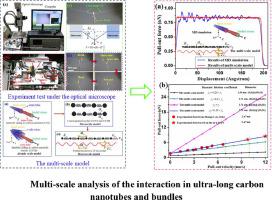Journal of the Mechanics and Physics of Solids ( IF 5.0 ) Pub Date : 2020-05-30 , DOI: 10.1016/j.jmps.2020.104032 Mengxiong Liu , Xuan Ye , Yunxiang Bai , Rufan Zhang , Fei Wei , Xide Li

|
Ultralow inter-wall interaction is realized in centimeter-long double-walled carbon nanotube (DWCNT) (Zhang, R. et al. Nat. Nanotech. 8, 912-916 (2013)). To further illustrate the mechanism of this special phenomenon, theoretical analysis combining with the experimental test is conducted, where study of the inter-tube interaction in the carbon nanotube bundles (CNTBs) is also included in this paper. In experiment, nanomanipulation difficulties of the ultra-long carbon nanotube (CNT)/CNTB is overcome by establishing a micro/nanoscale mechanical testing system (m/n-MTS), based on which the inter-wall/inter-tube interaction is firstly in-situ measured under optical microscope (OM). In theory, according to the bottom-up approach, a multi-scale model is developed specially, by which results obtained can be directly compared with the experimental data. The pull-out force consists of three parts: the boundary effect, the configuration force and the dynamic friction. The boundary effect can account for more than 70% when the pull-out velocity equals to 1 μm/s. The configuration force is greatly enhanced for the CNTB because of the commensurate configuration in the circumferential direction. The dynamic friction shows linear dependence on the pull-out velocity and relates to the overlapped area, which can be manifested when the pull-out velocity reaches to a dozen μm/s for the ultra-long DWCNT. The dynamic friction coefficient is proved to be 0.29 multiple of critical value based on the experiment data. The pull-out force in the CNTB is found far less than that in the DWCNT due to the greatly reduced contact area. Moreover, it can be deduced that the dynamic friction will show the same order of magnitude as the contribution from the boundary when the pull-out velocity equals to 10 μm/s or the length is 10 mm. This research reveals the underlying mechanism of the interaction, especially for the dynamic friction force exhibited in the ultra-long CNT/CNTB, and can provide help for designing devices with ultralow friction on macroscale.
中文翻译:

多尺度分析超长碳纳米管和束中的相互作用
超低壁间相互作用是在厘米长的双壁碳纳米管(DWCNT)中实现的(Zhang,R.等人,Nat。Nanotech。8,912-916(2013))。为了进一步说明这种特殊现象的机理,进行了理论分析与实验测试相结合,其中还包括了对碳纳米管束(CNTBs)中管间相互作用的研究。在实验中,通过建立一个微/纳米尺度的机械测试系统(m / n-MTS),克服了超长碳纳米管(CNT)/ CNTB的纳米处理难题,首先基于该系统可以进行壁间/管间相互作用在光学显微镜(OM)下原位测量。理论上,根据自下而上的方法,专门开发了一个多尺度模型,通过该模型可以将获得的结果直接与实验数据进行比较。拔出力由三部分组成:边界效应,构型力和动摩擦。当拉出速度等于1μm/ s时,边界效应可占70%以上。由于CNTB在圆周方向上的相应配置,因此对于CNTB的配置力大大增加。动摩擦对拉出速度表现出线性依赖性,并且与重叠区域有关,当超长DWCNT的拉出速度达到12μm/ s时就可以体现出来。实验数据表明,动摩擦系数为临界值的0.29倍。由于接触面积大大减小,因此CNTB中的拔出力远小于DWCNT中的拔出力。此外,可以推断出,当拉出速度等于10μm/ s或长度为10 mm时,动摩擦将显示出与边界贡献相同的数量级。这项研究揭示了相互作用的潜在机理,特别是对于超长CNT / CNTB中表现出的动态摩擦力,并可以为设计具有超低摩擦的器件提供帮助。











































 京公网安备 11010802027423号
京公网安备 11010802027423号